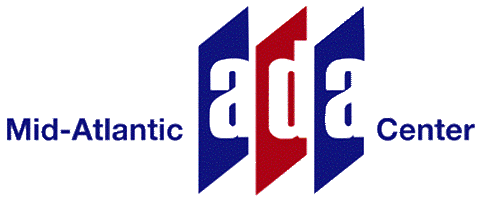(Printer-Friendly PDF Version | 292 KB)
(Large Print PDF version | 103 KB)
(Versión en español)
TAX INCENTIVES are available to encourage compliance with the Americans with Disabilities Act (ADA). This chart includes the Federal tax incentives and encourages you to inquire whether your state offers similar incentives. Unfortunately, many business owners and employers are unaware that these incentives exist. Make sure your business takes advantage of these valuable incentives!
| Name | Code / Publication | Eligibility | Purpose / Examples | Amount |
|---|---|---|---|---|
|
Architectural / Transportation Tax Deduction |
Code: Section 190: Barrier Removal IRS Publication: 535, Chapter 7 |
All businesses |
Removal of physical, structural, and transportation barriers Ex: widening doors, building ramps, modifying vehicles |
Max = $15,000 |
|
Small Business Tax Credit |
Code: Section 44: Disabled Access Credit IRS Form 8826 |
Small businesses |
Most expenses to comply with the ADA, including barrier removal, providing auxiliary aids/services, and accommodating employees Ex: Providing sign language interpreters, creating Braille documents, building ramps |
50% between $250 & $10,250 Max = $5,000 |
|
State Tax Credits |
States often offer additional tax incentives. Please contact your state tax office or your regional ADA National Network Center to learn more about these state-wide incentives. |
|||
Did you know?
► A small business is one that has 30 or fewer employees OR $1,000,000 or less in gross receipts from the previous year.
► If a credit exceeds the amount of taxes owed, businesses may carry forward the unused portion of the credit to the next year.
► Small businesses cannot claim a tax credit and deduction for the same dollar spent; however, they can use the incentives in combination, provided that the expenditures incurred qualify under both. See Example C.
► Physical modifications must comply with applicable accessibility standards.
EXAMPLE A, CREDIT: Restaurant ABC employs 25 individuals, and its gross revenue for last year was $3,000,000. It qualifies as a small business with fewer than 30 employees. Last year, ABC provided Braille and large print menus (an auxiliary aid), costing a total of $1,500. ABC removed physical barriers to the restaurant’s entrance and modified its transportation shuttle, totaling $8,000. Each of these expenditures qualifies under the Disabled Access Credit. To calculate ABC’s tax credit, start by adding the total amount spent on accessibility ($8,000 + $1,500 = $9,500) and subtract $250 ($9,500 - $250 = $9,250). Divide this amount by two ($9,250 / 2 = $4,625) to find the amount redeemable as a tax credit. ABC earned a tax credit of $4,625.
EXAMPLE B, DEDUCTION: Corporation XYZ removed barriers to its building two years in a row. Although the corporation deducted $4,000 from its taxes last year, XYZ spent money on an additional barrier removal project this year. This is an annual tax incentive, so XYZ is eligible for another tax deduction. XYZ removed all barriers from its bathrooms this year, which cost $8,000. XYZ is able to deduct this amount, $8,000, dollar for dollar, from the amount of money on which it pays taxes.
EXAMPLE C, CREDIT & DEDUCTION: Small business QRS spent $20,000 on access improvements by modifying their restrooms and front entrance. These expenditures qualify under both the tax credit and deduction, so QRS can use these incentives in combination. QRS may first take a tax credit of $5,000 (based on $10,250 of expenditures) and then deduct $15,000 (the difference between the total expenditures and the amount of the credit claimed).
For More Information
► ADA National Network: Free technical assistance: (800) 949-4232 V/TTY.
► Internal Revenue Service (IRS): Questions: (800) 829-1040 V; (800) 829-4059 TTY.
Publications and forms: (800) 829-3676 V; (800) 829-4059 TTY.
► U.S. Department of Justice (DOJ) Disability Rights Section: Questions: (800) 514-0301 V; (800) 514-0383 TTY.
This document is not intended to provide legal tax advice. Please consult the IRS or your tax advisor.
|
Content was developed by the Mid-Atlantic ADA Center, and is based on professional consensus of ADA experts and the ADA National Network. |
|
|
TransCen, Inc. |
The contents of this factsheet were developed under grants from the National Institute on Disability, Independent Living, and Rehabilitation Research (NIDILRR grant numbers 90DP0089 and 90DP0086). NIDILRR is a Center within the Administration for Community Living (ACL), Department of Health and Human Services (HHS). The contents of this factsheet do not necessarily represent the policy of NIDILRR, ACL, HHS, and you should not assume endorsement by the Federal Government. |
|
© Copyright 2017 ADA National Network. All Rights Reserved. |
|

.png)





